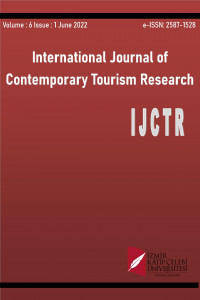A Criticism Of Contemporary Mass Tourism By Historical Analogic Approach
A Criticism Of Contemporary Mass Tourism By Historical Analogic Approach
Mass tourism, Historical analogy, Tourism system, Christianity Hellenism,
___
- Hall, M. (2008). Tourism planning, policies, processes and relationships, Second edition, Pearson: UK. Hause, S. & Maltby, W. (2004). Western Civilization: A History of European Society, Wadsworth Publishing: USA.IMF (2017). World economic outlook of april 2017. www.imf.org/en/publications/weo [Access Date: 19.02.2018]Kagan, D. (2007). An introduction to ancient Greek history, Open Yale Courses, http://www.acikders.org.tr/file.php/101/Lectures/PDF/Ders04.pdf [Access Date: 19.02.2018]Leiper, N. (1981). Towards a cohesive curriculum in tourism: the case for a distinct discipline. Annals of Tourism Research, 8(11), pp. 69-84. Page, S. (2007). Tourism Management: Managing for Change Second Edition. Elsevier: Oxford. Pew Research Center (2017). The changing global religious landscape. http://www.pewresearch.org/fact-tank/2017/04/05/christians-remain-worlds-largest-religious-group-but-they-are-declining-in-europe/ [Access Date: 12.02.2018]. Pomeroy, S. B., Burstein, S. M., Donlan, W., and Roberts, J. T. (2004). A Brief History of Ancient Greece Politics, Society, and Culture, Oxford University Press: New York. Santayana, G. (1905). The Life of Reason, Prometheus Books: New York. Turkish Culture and Tourism Ministry (2018). Statistics of tourism establishments with tourism investment certificate and operation license 2016, http://yigm.kulturturizm.gov.tr/TR,9860/turizm-belgeli-tesisler.html [Access Date: 22.02.2018].UNSD (United Nations Statistics Division) (2014). Population by religion, sex and urban/rural residence. http://data.un.org/Data.aspx?d=POP&f=tableCode%3A28 [Access Date: 27.02.2018].UNWTO (United Nations World Tourism Organization) (2017). Tourism highlights 2017 edition. https://www.e unwto.org/doi/pdf/10.18111/9789284419029 [Access Date: 19.02.2018].Urry, J. & Larsen, J. (2011). The Tourist Gaze 3.0, Sage Publishing: London. http://www.datagraver.com/case/world-population-distribution-by-latitude-and-longitude-2015 [Access Date: 19.02.2018].https://dictionary.cambridge.org/tr/s%C3%B6zl%C3%BCk/ingilizce/heaven [Access Date: 26.02.2018]. https://unstats.un.org/unsd/demographic-social/products/vitstats/seratab1.pdf [Access Date: 24.02.2018].http://www.bbc.com/news/magazine-19922863 [Access Date: 06.03.2018].
- Başlangıç: 2016
- Yayıncı: İzmir Katip Çelebi Üniversitesi
Developing Tourism in Foça: Views of Undergraduate Students
Otel İşletmelerinde Kurumsal Sosyal Sorumluluk Uygulamaları: Kuşadası Örneği
Yeşim GÜL ÖZDOĞAN, Osman Eralp ÇOLAKOĞLU
Turist Rehberliği Bölümleri Ders Programlarının “Türk Kimliği” Açısından İncelenmesi
Tolga Fahri ÇAKMAK, Füsun İSTANBULLU DİNÇER
Şırnak İlinin Gastronomi Turizmi Potansiyeli
A Strategic Performance Management Framework: A Hypothetical Hotel Case
A Criticism Of Contemporary Mass Tourism By Historical Analogic Approach
Reflections of Industry 4.0 To Management of Service Enterprises: Smart Hotels
Corporate Image, Brand and Reputation Concepts and Their Importance for Tourism Establishments
Turizm Sektöründeki Çevresel Sürdürülebilirlik Yatırımlarının Finansmanı, Muğla İli Örneği
